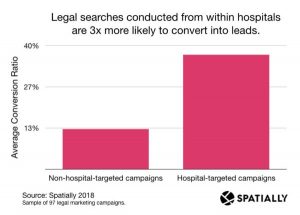Whether it’s only a year old or it’s from 10 years ago, when your website no longer impresses you, it’s hard to deal with it.

We get it. We love change as much as the next business.
But before you scrap it all in lieu of a shiny new website, you may want to think critically about the next iteration of your site.
We all know by now that modern marketing includes so many channels and platforms. Direct mail, social media (ads and organic), email, video, podcasts… it’s enough to make your head spin. But at the core of it all should be your website. It’s what fuels a content machine that drives views, leads, opportunities and revenue.
In addition to all of that is the fact that consumers today use mobile more than ever, and the design of your website is clearly critical to your brand’s success.
Here are the critical things to think about as you consider website development in your plan for business growth in 2020.
Website Development Consideration 1: Conversion Optimization/Lead Generation
Not every business’s website needs a complete overhaul. Sometimes, tweaking smaller things on your site can make a huge difference; auditing your conversion points could lead to serious improvements overall.
“If you skip the CTAs, your website doesn’t stand a chance at generating leads.”
Call-to-action (CTA) buttons that link to great offers in the different buying stages are a great place to start. Awareness (educational), consideration (comparison or case studies) and decision (consultations and audits) all get different CTAs. And they can all live in different areas of your website. Including your homepage!
Research shows that only 1 in 5 people want to talk to a salesperson while they’re in that awareness stage. They’re looking for resources, not a sales pitch. Make sure your CTAs help them wherever they are in their buyer’s journey.
If you skip the CTAs, your website doesn’t stand a chance at generating leads. To instill trust, your website has to enrich/inform the user and make yourself come across as a resource. Only then will your prospects want to buy from you.
Content offers on a website should educate your prospects, and help them get smarter about what they need. By providing them with this advice, they will come to understand how your business could potentially fill that need. These offers should also map to different stages of your sales process, so that leads generated can be nurtured accordingly.
Website Development Consideration 2: Search Engine Optimization
Think about your personal experience for a minute. When you hear about a new business, whether it’s from a friend or in an ad, do you search for the business online?
If a tree falls in the woods and no one hears it, does it make a sound?
If your business is talking but no one can find your website, are you even marketing?
Research shows that nearly all consumers begin their buying process by searching online. In fact nearly 90% of consumers search first. If you’re not found, are you doing business with modern buyers?
Here are 10 tips to improve your website’s search rankings:
- Optimize your site for mobile users
- Increase your page load speed
- Start blogging
- Make sure your site is readable
- Make your site a multimedia experience (video, audio, visuals)
- Use infographics
- Use keywords and keyword research
- Write engaging page titles and meta descriptions
- Provide accurate contact information
- Set up a Google My Business page
If your business isn’t ranking well for the words that describe your products and services, then you’re not getting found for them by potential customers either. SEO improvements may be all you need to make your website work for you.
Website Development Consideration 3: Research Mobile-Friendly Design
Look around in public. We’re all on our phones. If your website isn’t responsive to the different screen sizes we’re all on, you’re sunk. Did you know that 40% of users will quickly switch to a competitor’s website after a poor mobile experience?
Think about this: Smartphone usage is nearing 3 billion users as of 2020. 
Responsive design can help you solve a lot of problems for your website. It will make your site mobile-friendly, improve the way it looks on devices with both large and small screens, and increase the amount of time that visitors spend on your site. It can also help you improve your rankings in search engines.
A responsive website automatically changes the layout to offer an experience based on the device being used. It will reflect the difference between desktop/laptop, tablets and phones.
Your mobile-friendly responsive website should include these design elements:
- Readable text without requiring zoom
- Adequate space for tap targets
- No horizontal scrolling
Website Development Consideration 4: What’s Your Why?
There’s a million reasons to want a redesigned website.
From keeping up with the competition to updating the look to feeling bored with the design, businesses often look to a redesign to scratch an itch.
Real talk: Better reasons for a website redesign are:
You’re evolving to better serve your buyers.
OR
Your current site isn’t capable of achieving your marketing and sales goals.
This really isn’t about you. Your website exists for your consumers to use, not your team. So a redesign should be driven by their needs and preferences, not yours.
You need a site built for your buyer personas, with a strategy designed to serve them, as you work toward measurable business goals such as sales, leads and profit.
Website Development Consideration 5: How Should the Website Redesign Experience Look?
The final consideration is how this will look for you and your team. Are you prepared for this undertaking? A website redesign probably won’t be a quick fix. Quality work takes time and budget.
We can’t speak for every agency, but we know how this works at Impulse Creative and how we think it should look everywhere. Our data-driven approach to website redesign begins with a deep-dive into your current site. If what you have isn’t working for you anymore, we want to know why. That information fuels the strategy we use to make your site a success.
Site after site, our team is able to take tired, old websites and transform them into lead-generating powerhouses. We do it by focusing on the strategy behind the design, not just reskinning the same information.
A website redesign is your golden opportunity to restrategize and recharge your online marketing efforts with powerful tools and more effective information. Don’t let it be anything less.
By sharing our team’s approach to website redesign, we hope to show more brands the potential and possibilities these projects have for overhauling your online marketing.
A redesign can be so much more than a new look. It can reinvent the way you do business. Let’s explore how this will likely look step-by-step.
Start With a Website Audit
Before you decide to take on a website redesign, a website audit can give you a starting point for planning, based on real data collected over the course of several weeks.
If, after an audit, you choose to pursue a website redesign, you’ll understand your current site’s benchmarks and be better able to align your digital goals with a budget and timeline. Here’s an example of what this might look like for your business.

Week 1: The Kick Off
Initial meetings and interviews focused on your goals, challenges, competitors and ideal client personas.
Week 2: Traffic, Conversions and SEO
A detailed look at your website and marketing tools, an SEO audit, analytics analysis, website health report, and heat map research.
Week 3: Content
Assessment of your website content, its accuracy and length, page inventory, the buyer’s journey, brand persona, brand messaging, brand voice, grammar, and content depth.
Week 4: User Experience
Review the complete heat-mapped user experience of your website, from navigation to page loading speed, with recommendations and wireframes of improvements.
Let’s Talk Money
Custom websites require custom pricing. Don’t trust anyone who tells you otherwise.

Website redesigns aren’t an off-the-shelf product, so they can’t be priced that way. Ideally, you’re not just exchanging money for a product. You’re hiring a team of professionals to work with your team and create a unique digital space that achieves your goals.
So how is it priced?
Mostly, it’s in the amount of time it’ll take.
Whether it’s itemized and quoted as hours, points or something similar, you’ll almost always be billed for the amount of time your project takes (or is estimated to take), not flat rates. Unless, of course, you’re buying a website template, meaning a predesigned and developed website you can just plug your information into.
Website hosting platforms like WordPress and Squarespace are well-known for these base sites that start with flat-rate pricing. They’re not all bad! Really. Lots of businesses can accomplish their online goals with these simple sites. But many brands require more personality and functionality than these sites can offer or customize.
Scope and functionality are both major factors in a website’s price. Consider the differences between Amazon and the much smaller, simpler website of a small business.
Amazon has more than 580 million interactive product pages, a shopping cart, customized recommendations, smart content, interactive tools, streaming videos and just about every tech bell and whistle on the planet. Most businesses have fewer pages and a much less complex sitemap. Both can accomplish the goals of their brand, but at very different price points.
So while the hourly rate or total budget of each agency will vary some, the biggest factors in the price of your website redesign will be the scope and functionality.
The Process
Once you understand all of the options and have worked out a concrete plan with your team or agency, the process of your redesign can really begin. While the timeline and costs can vary greatly depending on the scope of your project, the basic process, from contract to completion, is pretty standard everywhere you go.
At Impulse Creative, our 60-90 day process is broken down into four distinct phases: discovery, design and content, development, and deployment.
Discovery & Strategy //
The beginning of your website redesign and initial meetings are focused on getting to know you and fleshing out your goals and strategy. If you’ve already done an initial audit of your website, those goals will be based on real data and the actual challenges you’re having with your current site (which may look a lot different than you think.)
A website audit will provide you with a full sitemap, a sketch of how the different pages and layers of your website will be organized, all based on competitive keywords and SEO. If your redesign isn’t preceded by an audit, you’ll begin discussing the sitemap and functionality of your website early on in the sales process in order to understand the scope of your project. Professional marketers will then help you to tweak and finalize the sitemap before design work begins.
An agency that uses an inbound marketing approach to website design will not just help you to establish goals for the look and functionality of your website. A marketing campaign will allow you to set goals around lead conversions, sales and profit. Regardless of the details, make sure your new site is designed to facilitate your company’s growth.
Another important piece of this phase is establishing processes and progress meetings for open, honest communication. You’ll likely have a project manager, or similar contact person, to be your eyes and ears throughout the project. Make sure you understand the timeline and processes for approvals, edits, scheduling, delays, and billing– before you sign anything. Then, stay candid and clear about what you want (and what you don’t.)
Design & Content //
Now that everyone has gotten to know each other and a solid plan is in place, everything starts happening fast. So fast, in fact, that it can actually be a little overwhelming. Prepare your team for this initial stage by understanding and communicating the heavy lifting you’ll need to do on your end.
Design will likely take the lead at this point, meeting to talk about what you like, what you don’t like, color schemes, layouts, typography, and your current website.
Then, they’ll process all of that information to create your first wireframes. These bare-bones designs will include a few different layouts for the types of different pages. You’ll work closely with the design team to nail down the style of the site and where the images or text will be placed.
After the design has your input, those wireframes are put into a more fleshed-out format called a mockup or comp. These will feature stock photos and dummy text to show you a more complete design without distracting you with real content.
At this point, you’ll want your major stakeholders to all take a look and approve the design, from layout to colors. Once it’s fully approved, these mocked-up pages will be used by your developers to code and create your custom page templates.
Development & SEO //
As design and content work begins to wind down, development and SEO will start to ramp up.
Fortunately for you, this portion of the website requires very little of your team (although it’s a huge effort on the part of your agency). You may never even meet your web developers. Unfortunately for you, it may seem like progress has stalled. It hasn’t, you just can’t see it yet.
All of that custom graphic design and content has to be inserted and programmed into your site’s platform. Then, your site needs to be told how to behave and function through line after line of code. It’s a time-consuming process that doesn’t always go as planned, especially if the functionality of your website is a little extra.
Your project manager will keep you updated as development progresses leading up to your launch date, though you likely won’t see it until it’s ready for you to revise. Smart What to Expect in a Website Redesign impulsecreative.com 17 content, calculators, interactive maps, and specialized tools can all pad your timeline with extra work for developers, something to keep in mind if you’re looking for a quick launch and fast turnaround.
As that technical tweaking is happening, marketers or SEO specialists will be busy optimizing each page, image and title tag, to give you an advantage in the rankings of search results. Depending on your contract, this initial SEO could be just laying a base for future tweaking as marketers respond to the ways users search for your site.
Deployment & Improvement //
You’ve finally made it to the finish line! Well, almost.
As development wraps up and your team puts their finishing touches on your redesigned website, you’ll be asked to go through it with your team, to find and correct any remaining errors or loose ends.
In a perfect world, there’s nothing out of place. In reality, there’s going to be some last minute fixes. Be mentally prepared. That’s simply the nature of creative work and technology with so many moving parts. Thankfully, your agency will have all hands on deck for this final push, correcting problems the second they’re noticed.
Once everyone has agreed your site is ready to go, a few virtual switches will be flipped and your old site will become your new site like magic. Another quick but thorough check of the site’s content and functionality will make sure nothing was lost in transit.
What’s Next?
Well, that depends on who you hired. Ask questions and shop around to avoid hiring an agency that walks away the moment your site is launched. Ideally, they’ll stick around, for a predetermined amount of time, to monitor and improve the site’s performance until you’re seeing the results you want, as in a certain number of leads or visitors.
You can learn more about what to expect in a website redesign project in our extensive guide here.
Research Photo by William Iven on Unsplash
Digital & Social Articles on Business 2 Community
(25)







